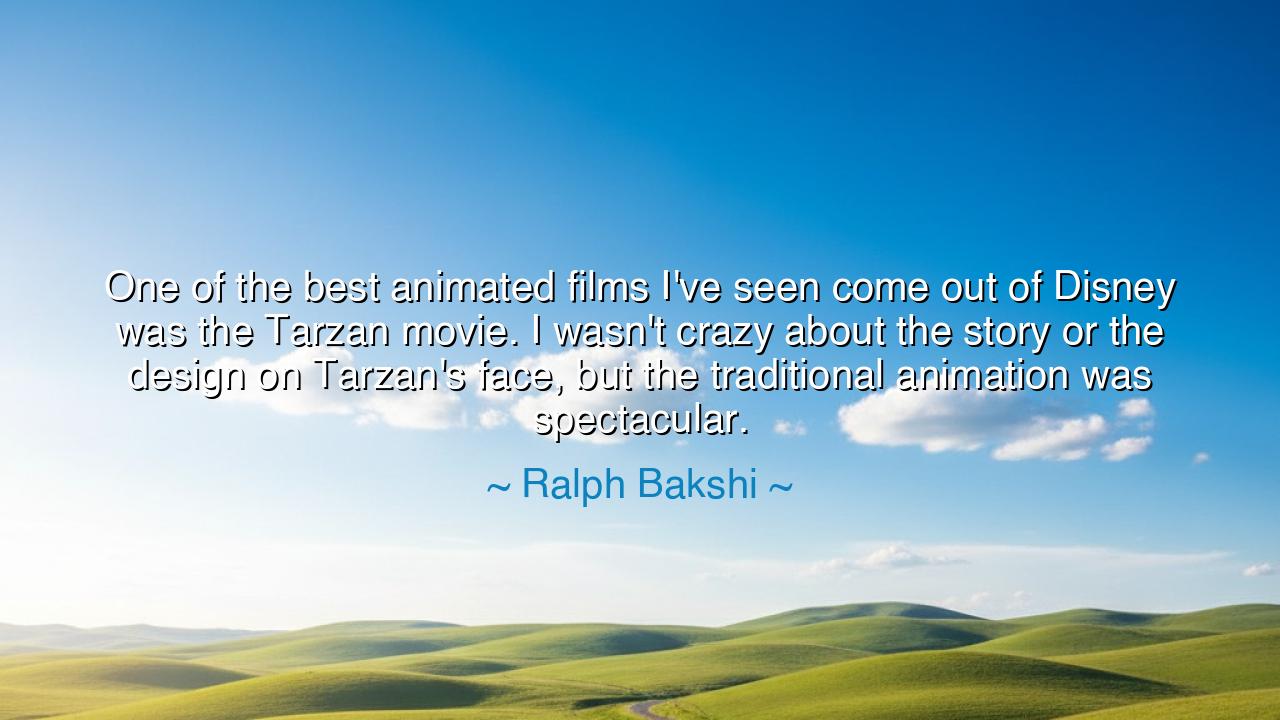
One of the best animated films I've seen come out of Disney was
One of the best animated films I've seen come out of Disney was the Tarzan movie. I wasn't crazy about the story or the design on Tarzan's face, but the traditional animation was spectacular.






The words of Ralph Bakshi — “One of the best animated films I've seen come out of Disney was the Tarzan movie. I wasn't crazy about the story or the design on Tarzan's face, but the traditional animation was spectacular.” — are not merely the reflections of an artist upon a film; they are the meditations of a master on the essence of craftsmanship. In this statement, Bakshi, the maverick director who broke convention in animation with raw creativity and fearless storytelling, speaks not of perfection but of reverence — reverence for the art of motion itself, for the sacred discipline that breathes life into stillness. He acknowledges imperfection in story and design, yet he bows before the sheer excellence of the traditional animation, which to him represented the spirit of a dying age: the art of the hand, the movement of the soul through line and form.
To understand the meaning of this quote, one must first know who Ralph Bakshi was — a man of rebellion and truth. In an era when animation was often bound to cheerful illusions and formulaic fantasy, Bakshi dared to speak through it with fire and honesty. His works, such as Fritz the Cat and The Lord of the Rings, were rough, human, imperfect — yet filled with the passion of one who believed that animation was not mere entertainment, but art in motion. Thus, when he praised Disney’s Tarzan (1999), it was not out of flattery, but out of genuine respect for the preservation of craft. For in that film, Disney’s animators combined new digital tools with the ancient discipline of hand-drawn art, creating movement so fluid and vibrant that it transcended its own story. Bakshi saw in it the flame of tradition still burning bright, even as the world was turning toward the cold precision of computers.
In calling the animation “spectacular,” Bakshi was honoring what the ancients might have called the vital breath of creation — that mysterious spark that separates the mechanical from the living. To him, the traditional art of drawing frame by frame was more than technique; it was a dialogue between the artist and the divine. Each stroke of the pencil carried emotion, imperfection, and soul. The human hand could capture what no algorithm could — the quiver of a leaf, the weight of a glance, the poetry in movement. And though he found fault in the design of Tarzan’s face or the simplicity of its tale, these were small matters beside the grandeur of that living motion. In it, he recognized something eternal: the spirit of craftsmanship that refuses to die, even in an age of convenience.
The ancients would have understood this well. In the temples of Egypt and the frescoes of Greece, in the scrolls of China and the mosaics of Byzantium, artists labored not for applause, but for mastery. They believed that art was a form of devotion, a way to honor creation by imitating its beauty through human effort. Likewise, the traditional animator, through patience and precision, mirrors the rhythm of life itself — breath by breath, frame by frame. Bakshi’s praise of Tarzan is not a critique of modernity alone, but a reminder that true art demands touch, that even amidst progress, the artist must never surrender the intimacy of creation.
Consider the story of Hayao Miyazaki, the great Japanese animator who, like Bakshi, defended traditional animation as a living art. When asked why he refused to abandon hand-drawn work for digital methods, he replied, “To make something you can touch, you must touch it.” This is the same truth Bakshi speaks through his admiration — that art is not born of machines, but of human will and tenderness. The line between the artist and his creation is sacred, and when that line is broken — when the artist’s hand no longer guides the work — something essential is lost. Thus, in Bakshi’s voice, we hear not nostalgia, but warning: that in forgetting the craft, we risk losing the soul of the art form itself.
There is humility, too, in his statement. Though Bakshi himself was a pioneer, he was not too proud to admire the work of others — even of a studio so different from his own. This humility reveals a deeper wisdom: that excellence recognizes excellence, even across style and ideology. The wise artist knows that art is a collective heritage, not a competition of egos. In praising Disney’s animators, Bakshi was honoring the lineage of all who have dedicated their lives to giving motion to dreams. His words remind us that to truly see art, one must look past one’s personal taste or prejudice, and behold the labor of the human spirit behind it.
So, my child, take this teaching to heart: admire the craft, not only the creation. Whether in art, in work, or in life, do not seek perfection of surface, but perfection of effort. The story may falter, the design may stumble, yet the spirit of genuine labor — the love of the craft — shines through and endures. Ralph Bakshi’s praise of Tarzan is a hymn to that enduring fire, that sacred pulse of creativity that survives the passing of ages. Cherish it, nurture it, and when the world turns cold and mechanical, keep the hand of humanity alive in all that you create. For it is not the perfection of the art that matters most, but the soul of the artist who dares to bring it to life.






AAdministratorAdministrator
Welcome, honored guests. Please leave a comment, we will respond soon